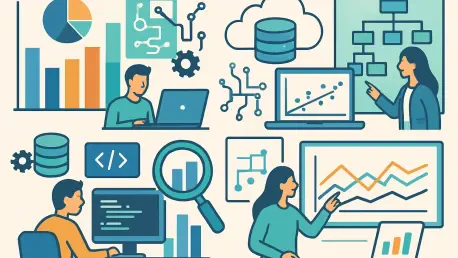As enterprises prepare for the challenges and opportunities of 2026, the role of data science in driving business success has never been more critical, with organizations racing to harness vast datasets for strategic advantage and to stay ahead in a competitive landscape. Data science has evolved from a niche field into a fundamental pillar of digital transformation, enabling companies to uncover hidden patterns, predict future trends, and make informed decisions that shape their competitive edge. However, with a crowded market of platforms and solutions, leaders such as CIOs and chief data officers face the daunting task of identifying tools that not only meet technical demands but also align with long-term business goals. The stakes are high, as the right choice can propel an organization forward, while a misstep could result in wasted resources and lost opportunities. This article explores the leading commercial data science tools poised to redefine enterprise analytics in the coming year. Unlike widely used open-source options like Python or R, the focus here is on robust, vendor-supported platforms designed for the scalability, security, and governance needs of large-scale environments. These solutions are more than mere software; they represent strategic investments capable of transforming how businesses operate, innovate, and collaborate. By delving into the features, trends, and capabilities of these tools, this discussion aims to guide decision-makers through the complex vendor landscape, ensuring they are equipped to build data-driven ecosystems that deliver measurable value.
The Strategic Importance of Data Science Platforms
In today’s fast-paced business environment, data science platforms have become indispensable for enterprises aiming to turn raw data into actionable insights that drive growth and efficiency. These tools empower organizations to process enormous volumes of information, develop sophisticated predictive models, and extract value that directly impacts bottom-line results. For global companies, the demands go beyond basic functionality; the chosen platform must handle intricate workflows while adhering to stringent regulatory requirements and integrating smoothly with existing IT architectures. This is particularly vital in industries like finance, healthcare, and manufacturing, where data sensitivity and operational scale amplify the need for reliable solutions. The ability to deploy these tools effectively can streamline decision-making processes, enabling leaders to respond swiftly to market shifts and customer needs. Moreover, as data becomes a core asset, the strategic selection of a platform is not just a technical decision but a business imperative that can define an organization’s trajectory in a competitive landscape.
Beyond their technical prowess, data science platforms play a crucial role in sparking innovation and fostering a culture of data-driven thinking within enterprises. They provide the infrastructure for data teams to experiment with new ideas, test hypotheses, and uncover insights that might otherwise remain hidden. This capacity for innovation is often what separates industry leaders from followers, as it allows companies to anticipate trends and adapt proactively. Additionally, these tools bridge the gap between technical experts and business stakeholders by presenting complex analyses in accessible formats, ensuring that insights lead to practical outcomes. As the market continues to evolve, enterprises must prioritize platforms that not only address current needs but also anticipate future challenges, offering flexibility to scale and adapt. The investment in such tools is a commitment to long-term competitiveness, highlighting their significance as more than just operational aids but as catalysts for transformation.
Core Capabilities Shaping the Next Generation of Tools
A defining feature of the data science tools expected to dominate enterprise use by 2026 is their ability to support the entire analytics lifecycle, from data preparation to model deployment and ongoing monitoring. Platforms like DataRobot and IBM Watson Studio exemplify this comprehensive approach, providing seamless environments where every stage of the data science process is managed within a single ecosystem. This end-to-end support eliminates the inefficiencies of juggling multiple disparate tools, allowing teams to focus on deriving insights rather than navigating technical complexities. For large organizations, this unified workflow is essential, as it minimizes errors, reduces time-to-value, and ensures consistency across projects. Such capabilities are particularly beneficial in high-stakes scenarios where precision and speed are paramount, enabling enterprises to maintain a competitive edge through streamlined operations. As businesses grapple with ever-growing data volumes, the demand for such all-encompassing solutions continues to rise, signaling a shift toward more integrated platforms.
Another transformative capability is the emphasis on automation, which is broadening access to data science across skill levels within enterprises. Tools incorporating Automated Machine Learning, or AutoML, such as ##O.ai and Google Cloud AI Platform, simplify intricate tasks like model selection and parameter tuning, making them manageable even for those without deep technical expertise. Similarly, platforms like Alteryx and KNIME offer no-code or low-code interfaces, allowing users to build workflows through intuitive, visual drag-and-drop systems. This democratization of data science empowers non-specialists, such as business analysts, to contribute meaningfully to analytics initiatives, fostering a more inclusive approach to data-driven decision-making. By reducing barriers to entry, these tools ensure that the benefits of data science permeate throughout an organization, enhancing overall productivity and encouraging cross-departmental collaboration. This trend toward accessibility reflects a broader industry recognition that data science must be a shared capability, not confined to a select few.
Navigating Scalability and Ecosystem Integration
Scalability stands as a non-negotiable requirement for data science tools targeting enterprise environments, where the ability to handle massive datasets and dynamic workloads is essential for operational success. Platforms like Databricks, built on the powerful Apache Spark framework, excel in delivering unified analytics across cloud providers such as AWS, ensuring that organizations can process data at scale without performance bottlenecks. Similarly, Microsoft Azure Machine Learning integrates tightly with the Azure ecosystem, offering robust options for model training and deployment that adapt to growing data demands. This adaptability to cloud, on-premises, or hybrid setups is critical for enterprises with complex, evolving IT infrastructures, allowing them to maintain agility in the face of technological change. Such scalability ensures that businesses can manage real-time analytics and support global operations, meeting the needs of distributed teams and diverse markets without compromise. As data continues to grow exponentially, tools that prioritize this flexibility will remain at the forefront of enterprise adoption.
Integration with existing systems and open-source frameworks further enhances the appeal of these data science platforms, striking a balance between innovation and familiarity for enterprise users. Tools like Anaconda Enterprise and IBM Watson Studio stand out for their compatibility with popular languages and libraries such as TensorFlow, PyTorch, and scikit-learn, enabling data scientists to leverage familiar environments while benefiting from enterprise-grade features like enhanced security and governance. This synergy allows organizations to preserve investments in existing skill sets and tools while adopting commercial solutions that offer vendor support and scalability. The result is a seamless transition for teams accustomed to open-source workflows, ensuring continuity in operations while introducing advanced capabilities tailored to large-scale needs. This integration not only boosts efficiency but also fosters confidence among stakeholders, as it minimizes disruption and maximizes the value derived from both new and legacy systems in the enterprise ecosystem.
Prioritizing Governance and Team Collaboration
In industries handling sensitive data, such as healthcare and finance, governance and compliance are paramount considerations for any data science tool, as they directly impact trust and regulatory adherence. Platforms like Google Cloud AI Platform and Microsoft Azure Machine Learning address these concerns by embedding features for data privacy, model interpretability, and continuous monitoring, ensuring that AI-driven decisions are transparent and accountable. These capabilities are essential for meeting stringent legal and ethical standards, particularly in environments where data breaches or biased outcomes can have severe consequences. By prioritizing explainability, these tools help stakeholders understand the rationale behind predictions, building confidence in automated systems. As enterprises navigate an increasingly regulated landscape, the ability of a platform to safeguard data and maintain compliance becomes a key differentiator, influencing adoption decisions and shaping long-term strategies for responsible AI implementation.
Collaboration is another critical area where modern data science tools are making significant strides, recognizing that analytics is often a collective endeavor requiring input from diverse teams. Solutions like Dataiku and Domino Data Lab are designed with team-based workflows in mind, offering shared environments and workbenches that facilitate efficient cooperation among data scientists, analysts, and business users. Features such as Databricks’ collaborative workspace further enhance this by enabling real-time interaction and knowledge sharing, even in geographically dispersed settings. This focus on teamwork not only boosts productivity but also ensures that insights are aligned with organizational objectives, as varied perspectives contribute to more robust outcomes. In an era where remote and hybrid work models are commonplace, the capacity of a tool to support seamless collaboration across distances is invaluable, positioning it as a vital asset for enterprises aiming to maximize the impact of their data initiatives.
Charting the Path Forward with Strategic Investments
Reflecting on the evolution of data science tools, it’s evident that the platforms shaping enterprise landscapes by 2026 had already begun addressing critical needs for scalability, accessibility, and governance in prior years. Their ability to manage the entire analytics lifecycle, from raw data to actionable insights, had set a benchmark for what businesses came to expect from technology investments. Automation features like AutoML and intuitive interfaces had started breaking down barriers, allowing a wider range of professionals to engage with data science processes. Meanwhile, robust integration with cloud systems and open-source frameworks had ensured that these tools could adapt to diverse IT environments, providing the flexibility required by global organizations. The emphasis on compliance and ethical AI practices had also gained traction, responding to growing regulatory scrutiny and public demand for transparency in automated decision-making.
Looking ahead, enterprises must focus on aligning their technology choices with overarching business strategies to maximize the value of these powerful tools. Decision-makers should evaluate platforms based on specific organizational needs, considering factors such as data volume, team expertise, and industry-specific compliance requirements. Exploring pilot programs or proof-of-concept initiatives can provide valuable insights into how a tool performs within a unique operational context, minimizing risks associated with full-scale deployment. Additionally, fostering a culture of continuous learning will ensure that teams remain adept at leveraging evolving features and capabilities. By approaching these investments with a forward-thinking mindset, businesses can position themselves to not only meet the challenges of 2026 but also anticipate future shifts in the data science landscape, securing a sustainable competitive advantage.









